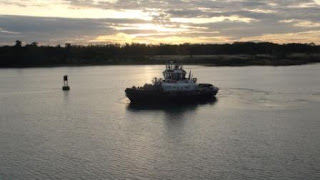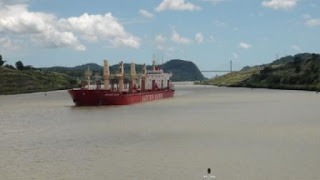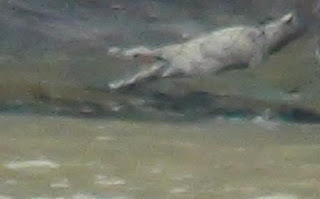As we had been told that the boat was scheduled to enter the first locks of the Panama Canal at around 7am, I was determined to be up early and be on deck as the anchor was pulled up. So, I woke at about 5.30am and went up to watch the sunrise and the boat leave anchor to enter the Canal.
The first part of the Canal is just like a wide river. A small tug went past us in the opposite direction.
After about an hour we saw, on the right-hand side, the entrance to a small canal. The Panamanian guide on the boat told us this was the remains of the French attempt to build the first canal across Panama in 1888. The project was eventually abandoned, but only after the French suffered over 21,000 deaths, mainly due to malaria and yellow fever.
Shortly after, we came to the Gatun locks, a stairway set of locks that lifts ships a total of 85 feet, in three stages. To the left of the locks, we could see the work that is going on to build new locks that will take much larger ships through the canal.
Currently, the largest ships the Canal can accommodate are up to 1,000 feet in length. These are known as Panamax ships. When the new locks are completed in 2014, this will increase to 1,450 feet. For container ships, this will mean an increase in carrying capacity from 5,000 containers to 12,000 containers! The cost of the Canal expansion is over $5 billion dollars.
As we entered Gatun locks we saw a small rowing boat leave the lock side and position itself under our bow. We watched as a rope was thrown from the ship to the rowing boat, which then took the rope to the quay. It was quite a surprise to see such an old-fashioned way of securing the ship!
The rope was tied to a hawser that came out of the side of a 'mule'. The mules are electric-powered trains that guide/pull ships through the locks. Four mules are used for each ship with two on each side - two at the front and two at the rear. As a ship goes through the locks, the drivers of the mules are given instructions by the pilot onboard the ship. It is very impressive to watch the way the mules operate as they move up the lock. They have to go up steep ramps as the boats travel forward.
Waiting to enter the first lock. You can see a bus going across the swing road bridge that moves aside to allow boats to go into the lock.
As we entered Gatun Locks, we could see this large car transporter ship entering the second lock alongside ours. It is amazing how little space these ships have on each side of the locks. In some cases this can be as little as two feet.
Just in front of the car transporter ship was an oil tanker, registered in Douglas, Isle of Man. It showed me how varied the traffic is that goes through the Canal.
Gatun Locks and the control tower.
We progressed through the three stages of Gatun Locks and emerged on to Gatun Lake, which was the world's largest man-made lake when it was created as part of the Canal system in 1914. The lake is a total of over 160 square miles and we sailed past the sluice gates of the dam as we exited the Gatun Locks.
We sailed across Gatun Lake for a few hours, with many large container and cargo ships passing us in the opposite direction. We then came to the narrowest part of the Canal, the Cabrera cut. This is an eight mile manmade canal that had to be cut through the mountains, which form the continental divide. Much of this part of the Canal is being widened and deepened as part of the Canal expansion project.
Our friend, George from Munich, with whom we spent several enjoyable evenings.
I saw a group of passengers pointing at the bank of the canal and, lying in the sun, there was this large crocodile with its mouth gaping open. My camera was on maximum zoom, hence the slightly blurred photo.
Approaching the Centennial Bridge and passing under it.
After we had passed the Centennial Bridge, we came to the second set of locks, Pedro Miguel, a single lock system. Again, we were met by the rowing boat and the mules that pulled us through the lock.
A short distance further on, we came to the last set of locks, double this time. These were the Miraflores Locks. Alongside the locks, you could see the massive amount of building work taking place to construct the new lock system. Cranes, diggers and dozens of huge earth-moving trucks were all in operation. It is a truly vast building project!
On the left-hand side of the locks was the visitor centre where we had celebrated the end of our 2006 Drive, The Panamericana. We had our final Drive dinner in the visitor centre restaurant, watching the boats being pulled through the locks. This was when we made the decision to return one day to go through the Panama Canal.
You can just see the crowds of visitors, on all three levels, watching the ships going through the locks.
A couple of miles further on and we went under the Bridge of the Americas, the bridge that carries the Pan-American Highway across the Canal. Just before the bridge, we saw the D'Artagnan, the world's largest dredging vessel, which is being used to deepen the Canal.
A little farther on, we went past this extraordinary building, designed by the renowned American architect Frank Gehry. It is the new Museum of Bio-diversity.
It was then about a mile to the end of the Canal and the Pacific Ocean. Just before we left the Canal for the Pacific, a pilot boat came up alongside the ship to take the pilot off Silver Explorer. He had been with us for the whole journey through the Panama Canal. Once again, we saw the familiar skyline of Panama City, this time from the deck of Silver Explorer.
What a wonderful trip it has been!
Bob and me looking out at the Pacific after exiting the Canal.
We then headed out into the Gulf of Panama for our overnight destination in the Pearl Islands. We reached our anchorage at about 6pm. Tomorrow we are going ashore at an island called Isla Contadora, meaning accountant, so named because the Spanish used to take stock of their pearls, prior to shipping them back to Spain.




































No comments:
Post a Comment